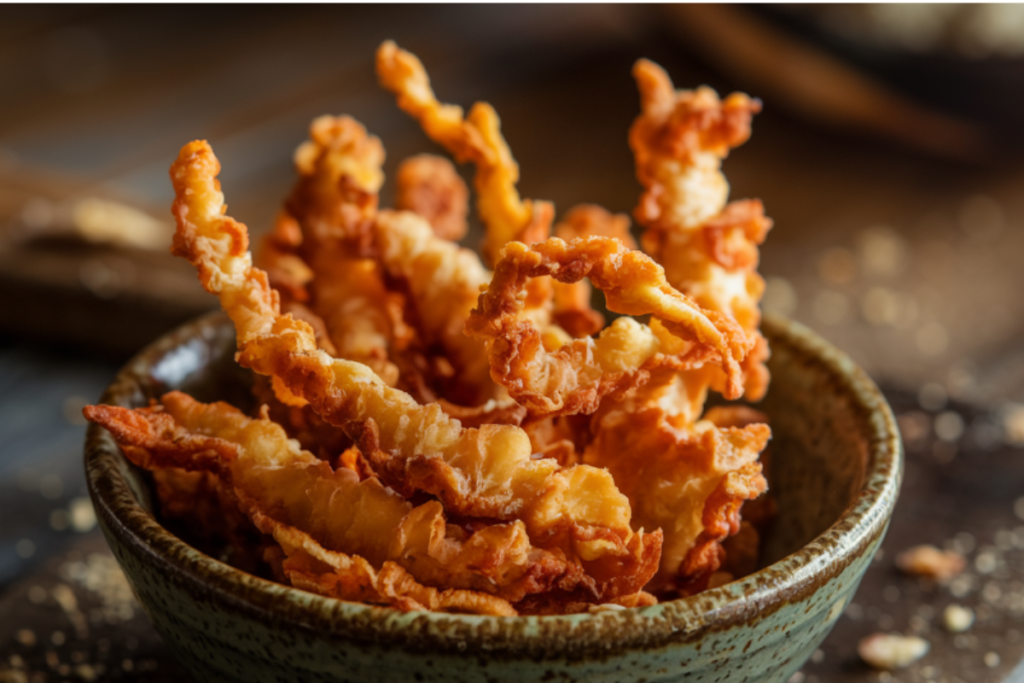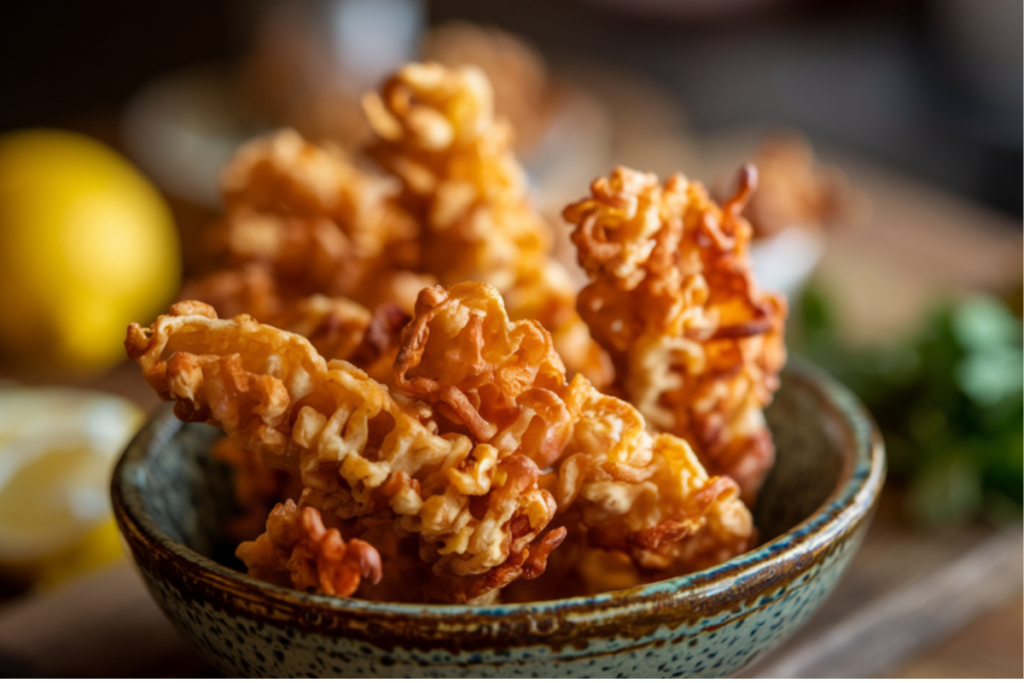Chicharrones, a beloved snack across Latin America and beyond, have captured the hearts of food enthusiasts everywhere. Known for their crispy texture and savory flavor, chicharrones are a culinary delight that bridges tradition and modern cuisine. In this comprehensive guide, we’ll explore the origins, types, preparation methods, and much more about this iconic dish.
Part 1: Introduction
Chicharrones are more than just a snack; they are a cultural symbol in many Latin American countries. Made typically from pork skin, chicharrones are fried to create a crunchy and addictive treat. While pork is the most common base, you can also find variations made from chicken, fish, or even plant-based ingredients.
The appeal lies in their versatility. Whether enjoyed as a snack, a topping for dishes, or a main course, their rich flavor and satisfying crunch make them irresistible. With their roots deeply embedded in Latin American culture, chicharrones have now become a global phenomenon, appearing in various forms around the world.
Part 2: The Origin of Chicharrones
The history of chicharrones dates back centuries, with each region adding its unique twist to the dish. Originally from Spain, were brought to Latin America during the colonial period, where they quickly became a staple.
Regional Variations
- Mexico: In Mexico, chicharrones are often enjoyed as a street food, served with lime, hot sauce, and a sprinkle of salt. They are sometimes made from pork belly, which offers a meaty bite alongside the crispy skin.
- Colombia: Colombian , also known as chicharrón colombiano, are typically thicker and meatier, often including a layer of fat and meat under the skin. They are a popular accompaniment to dishes like bandeja paisa.
- Philippines: In the Philippines, chicharrones are called chicharon, and they come in various forms, including pork, chicken, and fish. These are often served with vinegar and garlic for dipping, adding a tangy contrast to the rich flavor of the fried skin.
The evolution has led to a diverse array of preparations, each reflecting the local ingredients and culinary traditions of the region.
Part 3: Different Varieties of Chicharrones
Chicharrones are as diverse as the regions they come from. While pork chicharrones are the most common, there are several other types worth exploring.
1. Pork
These are the classic chicharrones, made from pork skin, belly, or a combination of both. The key to perfect pork is achieving the right balance between crunchy skin and tender meat.
2. Chicken Chicharrones
For a lighter alternative, chicken chicharrones offer a leaner option with the same satisfying crunch. These are made from chicken skin, often seasoned with a variety of spices before frying.
3. Fish Chicharrones
Popular in coastal regions, are made from fish skin. They provide a crispy texture with a subtle seafood flavor, making them a unique twist on the traditional dish.
4. Vegan Chicharrones
With the rise of plant-based diets, vegan chicharrones have gained popularity. These are often made from ingredients like wheat or cassava, offering a crunchy bite without any animal products.
5. Regional Differences
Different countries have their take on chicharrones, each adding a distinct flavor profile. In Mexico, for instance, you might find de harina, a puffed wheat snack that mimics the texture of fried pork skin.
Part 4: How to Make Chicharrones
Making chicharrones at home is a rewarding experience that allows you to customize the flavors and textures to your liking. Here, we’ll explore both traditional and modern methods of preparation.
Traditional Method
The traditional method of making involves deep-frying pork skin until it reaches the perfect level of crispiness. Here’s a step-by-step guide:
- Ingredients:
- 2 pounds of pork belly or skin, cut into pieces
- Salt
- Water
- Oil for frying
- Instructions:
- Prepare the Pork: Start by seasoning the pork with salt. Let it rest for a few hours to allow the salt to penetrate the skin.
- Boil the Pork: Place the pork in a large pot and cover with water. Bring to a boil and cook until the water evaporates and the fat begins to render.
- Fry the Pork: Once the water has evaporated, the pork will start frying in its fat. Continue to cook until the pieces are golden brown and crispy.
- Tips for Perfection:
- Temperature Control: Ensure the oil is hot enough to crisp the skin but not so hot that it burns the chicharrones.
- Drying the Skin: For extra crispy chicharrones, dry the pork skin thoroughly before frying.
Authentic Latin American Recipes can provide further inspiration for your preparation.
Modern and Healthier Variations
If you’re looking for a healthier alternative, consider baking. These methods reduce the fat content while still delivering a satisfying crunch.
- Baked : Season the pork skin as usual, then bake in a preheated oven at 400°F until crispy. This method reduces the amount of oil needed and results in a lighter snack.
- Air-Fried : Air frying is another great option for those seeking a healthier version. Simply place the seasoned pork skin in an air fryer and cook at 375°F for 15-20 minutes.
For more information on the nutritional benefits and potential health drawbacks of pork rinds, check out this Nutritional Information on Pork Rinds.
Part 5: Popular Recipes
Chicharrones can be enjoyed in many ways, whether as a snack, a side dish, or the star of a meal. Here are five popular recipes to try at home.
Recipe 1: Classic Pork Belly
- Ingredients:
- 2 pounds of pork belly
- 2 teaspoons of salt
- 1 teaspoon of baking soda
- Lime wedges for serving
- Instructions:
- Prepare the pork belly by scoring the skin and seasoning with salt and baking soda.
- Let the pork rest for several hours.
- Fry the pork belly in hot oil until golden and crispy.
- Serve with lime wedges for an added zing.
Chicken
- Ingredients:
- 1 pound of chicken skin
- Salt and pepper to taste
- 1 teaspoon of garlic powder
- Instructions:
- Season the chicken skin with salt, pepper, and garlic powder.
- Fry in hot oil until crispy.
- Drain on paper towels and serve hot.

Colombian-Style
- Ingredients:
- 2 pounds of pork belly
- 2 teaspoons of salt
- 1 teaspoon of baking soda
- Instructions:
- Rub the pork belly with salt and baking soda.
- Cook the pork in a large pot over medium heat until crispy.
- Serve with traditional Colombian sides like arepas or beans.
Vegan
- Ingredients:
- 1 cup of wheat gluten
- 1 teaspoon of soy sauce
- 1 teaspoon of liquid smoke
- Instructions:
- Mix the wheat gluten with soy sauce and liquid smoke.
- Form into thin pieces and bake until crispy.
Spicy
- Ingredients:
- 2 pounds of pork skin
- 1 teaspoon of cayenne pepper
- 1 teaspoon of paprika
- Instructions:
- Season the pork skin with cayenne pepper and paprika.
- Fry until golden and crispy.
- Serve with a side of hot sauce for extra heat.
Part 6: Chicharrones in Popular Culture
Have made their mark not only in kitchens but also in popular culture. They are frequently featured in movies, TV shows, and even literature, highlighting their role as a symbol of comfort food.
Representation in Media
- Movies and TV Shows: often appear in scenes depicting Latin American culture, showcasing their importance as a staple food. They are commonly seen in street food scenes or as part of a family meal.
- Street Food Culture: In many Latin American countries, chicharrones are synonymous with street food. Vendors sell them by the bag, freshly fried and seasoned, offering a quick and satisfying snack for passersby.
Influence on Modern Culinary Trends
The versatility has inspired chefs to incorporate them into modern dishes. From fine dining restaurants to food trucks, chicharrones are being used as toppings, ingredients, and even as a base for innovative creations.
Part 7: Health Considerations
While delicious, are not without their nutritional concerns. It’s important to understand their nutritional profile and how they can fit into a balanced diet.
Nutritional Profile
- Calories: Chicharrones are calorie-dense, with a typical serving containing around 150-200 calories.
- Fat Content: High in fat, particularly saturated fat, should be consumed in moderation to avoid negative health impacts.
- Protein: Despite their high-fat content, chicharrones are also a good source of protein, making them a popular snack for those on low-carb or ketogenic diets.
Chicharrones for Special Diets
- Low-Carb and Keto: Chicharrones are a popular choice for those following low-carb or ketogenic diets due to their high-fat and low-carb content.
- Gluten-Free: Since traditional chicharrones are made from pork, they are naturally gluten-free, making them a safe option for those with gluten sensitivities.
Part 8: Buying and Storing
Finding high-quality chicharrones and storing them properly can make a big difference in your culinary experience.
Where to Buy the Best Chicharrones
- Supermarkets: Many supermarkets carry pre-packaged chicharrones, often found in the snack aisle.
- Specialty Stores: For a more authentic experience, visit a Latin American grocery store where you can find freshly made .
- Online: Several online retailers offer a wide variety, from traditional pork skin to vegan options.
Storage Tips
- Homemade Chicharrones: Store in an airtight container to keep them crispy. They can last for several days at room temperature.
- Store-Bought Chicharrones: Once opened, keep the bag sealed tightly to an airtight container to maintain their crunch.
Part 9: FAQs about Chicharrones
Here are some frequently asked questions about chicharrones, covering everything from their ingredients to their preparation.
- What are chicharrones made of? Chicharrones are traditionally made from pork skin, but they can also be made from chicken, fish, or plant-based ingredients.
- Are chicharrones healthy? are high in fat and calories, so they should be enjoyed in moderation. However, they are also a good source of protein.
- Can I make chicharrones at home? Yes, making chicharrones at home is quite simple and allows you to control the ingredients and seasoning.
- What’s the difference between chicharrones and pork rinds? Chicharrones typically include a layer of fat and meat along with the skin, while pork rinds are made solely from the skin.
- How do I make crispy chicharrones? The key to crispy chicharrones is drying the skin thoroughly before frying and maintaining the right oil temperature during cooking.

Part 10: Conclusion
Chicharrones are a delicious and versatile snack that has stood the test of time. Whether you’re enjoying them as a quick bite, using them as a topping for dishes, or exploring new recipes at home, chicharrones offer a satisfying crunch and rich flavor that is hard to beat. With a deep cultural significance and endless variations, are more than just a snack—they are a celebration of culinary tradition.
So why not try making your own chicharrones or exploring the many varieties available? With the right ingredients and a little know-how, you can bring a taste of Latin America into your kitchen and enjoy the crunch of this beloved dish anytime.

